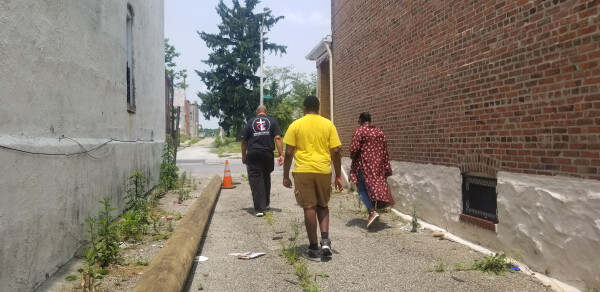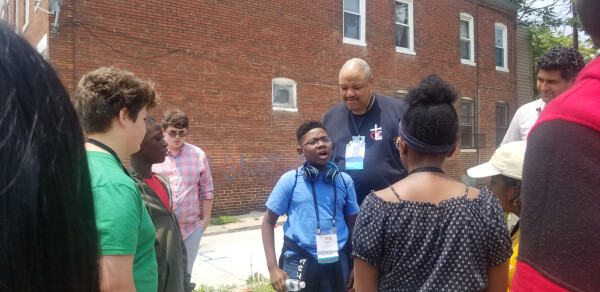Same City -- Two Different Realities: A Confirmation Transformation Tour
By Sharon Milton
On June 1, the last day of Annual Conference, we boarded two buses that left Marriott at Baltimore’s Inner Harbor, as part of learning lab, which invited confirmands to explore Methodist history and urban ministry. We headed to another part of Baltimore -- same city, two different realities.

The Rev. Tim Warner, right, with back to the camera, lead a group of confirmands to visit urban ministry settings in Baltimore during the recent Annual Conference Session.
Photo courtesy of Sharon Milton.
The ride from the harbor was nice and smooth -- beautiful condos, Starbucks on every corner, tourists and restaurants everywhere -- but as we drove further the first thing the youth noticed was that the roads started to get bumpier, graffiti appeared on the walls, potholes were everywhere -- same city, two different realities; but God is in both of those places.
This lab was lead by the Rev. Tim Warner, who served on the Conference staff more than a decade ago, doing ministry in these communities. The youth and leaders on this trip were from the Greater Gaithersburg Youth Ministry (GGYM) and Emory UMC in D.C. The Rev. Jennifer Fenner of Epworth UMC and my pastor, the Rev. Joe Daniels, also joined this tour. The Holy Spirit would send transformation before the tour was over.
The first stop was at Lovely Lane UMC, where we heard the history of the early U.S. church. As Pastor Warner described how Lovely Lane was pivotal in organizing the early church, he also described how Lovely Lane was used as the organizing site for Saving Stations and Shalom Zones, two Conference efforts at restoring the devastation of the city caused by systemic evil.
"Do you accept the freedom and power God gives you to resist evil, injustice, and oppression in whatever forms they present themselves?" It was the baptism/confirmation question of the day.
Then Warner prepared the confirmands for our next stop, what we would see in those streets, and how it connected to the call of God on their lives.
We boarded the buses again, and drove through Sandtown to where Freddy Gray was killed. We passed the CVS drugstore that was set on fire during the riots. There were so many people outside, and loud music was playing everywhere. The abandoned houses went on for blocks. Warner explained where we were and what had happened there.
The youth were told to look out the windows and take in what they saw. The looks on their faces showed hurt and confusion. They didn’t understand how we could be so close to the Harbor, but yet worlds apart. One teen said, “This is what gentrification looks like!”
Warner reminded them again to keep a look out to see where God is calling us as a church, and how it is connected to the call on their young lives. He stressed that the building is not the church. The youth took all this information in, and it was clear by the look in their eyes that the Holy Spirit was speaking to them.

We passed many signs posted everywhere that read, “We buy houses with cash." Pastor Daniels, explained to us, “That sign is the new check cashing place.” It is not what it appears to be, he said, it is not helping you out; it is designed to keep you down. That was an eye-opener for all. These confirmands have been called for a time such as this. And they were learning first-hand that as disciples of Christ, God calls us to go!
Going to East Baltimore, a whole other world, we passed many abandoned houses and finally stopped at a vacant lot on the corner of Milton and Oliver streets. Warner asked everyone to get out of the bus. As we gathered in that lot, he explained that years ago this used to be a United Methodist church that was abandoned by the congregation as the city changed during “white flight,” and had eventually burned down and was eventually imploded into the ground.
He talked about how one of the longest-standing and most successful Saving Stations had been held on this exact lot nearly 20 years ago. Bishop Felton Edwin May had assigned him to the streets of Baltimore, and how, right in that parking lot, they put up tents for God’s people to be present during the day, and lead street revivals at night.
Yes, in the midst of the broken bottles, drug needles and everything else, led by the Holy Spirit, United Methodists were saving souls right there on the streets. No doors, no pews, no paraments, no roofs, yet hundreds were getting saved. Drug addicts and dealers, prostitutes, homeless, hungry; the least, the last and the left-out alike, hundreds came to know Jesus as Savior and Lord. I imagine it was like the day of Pentecost!
Warner asked them the question again: “As you are being confirmed, what is God calling you to do? Who are the people God is sending you to? What does your confirmation mean as a follower of Christ?”
I could see in their eyes that they were now wrestling with the question of call, and that’s a great place to be. As he led us down a back alley where people still live despite the homes being boarded-up, he told the youth, “I want you to imagine this is where you live every day, that this is your situation. I want you to feel it, smell it and hear it.”
As we left the lot, he asked them to share their observations. One said, “I felt scared and abandoned.” Another said, “It smelled like strong pee. It made me want to get away!” Still, another said, “I felt trapped.”
He then asked them again, “You all will be confirmed soon. What does confirmation mean to you? What does God want out of the deal? How does that back alley relate to Jesus Christ?" One youth said, “There is life back there, but it’s left for dead.”

We now stood at the corner of the vacant lot, no longer a saving station. Spray-painted on the wall of a side street was a message: “NO SHOOT ZONE.” Across the street was a funeral home which had expanded over the years. It broke my heart when Warner said of the legacy of this work, “The work which was bringing life in this vacant lot was closed down, but a place which profits from death has been expanded. We traded life for death.”
The youth and leaders had many questions about how the body of the church could turn away from these people. Were we trading life for death? Has this side of Baltimore been forgotten? They were about to be confirmed into membership; how is God calling them to help?
Warner asked them, “You need an iced frappuccino latte? Where is the Starbucks in this neighborhood? The CVS? The Whole Foods?" Their young eyes lit up in amazement. They now realized what a food dessert was. There were no stores for miles in these neighborhoods, and because this wasn’t what they were used to, they now knew that this was the kind of place where God calls us to go.
As we walked back to the bus, Daniels and Warner reminisced about the Saving Stations and all the lives it touched, and my heart yearned to be a part of Saving Stations, realizing that God has many Saving Stations for us to start, and the youth will play a very important part.
Our final stop was the former St. Paul’s UMC on N. Linwood Street., the parsonage of which was converted into a short-term rehabilitation site for the many heroin addicts who were committing to Christ through Saving Stations. We stood on the steps as Warner shared the story of his call to pastoral ministry precisely in that place.
While walking past the church on a Fall Friday night, he encountered a group of young people gathered on those steps in the dark. There was no other safe place to gather to hang out. The church windows were shuttered, and the doors were boarded up. The light on the front steps was broken out, and he heard God speaking to him, saying, “The congregation is gathered at my house. The doors are covered and there is no one to pastor them. You have been calling out to me about the condition of the city, now I’m calling you to pastor my people.”

Just then, a search helicopter hovered over them and shined its light right on him, and he knew that God wanted his attention now. We were all in tears as he shared his story with the same passion he felt that night, and the Holy Spirit filled the corner. Transformation was taking place, as he asked them again, “How is God speaking to you? Where is God calling you?”
As we prepared to pray on that corner, he told us of his disappointment when he asked Bishop May about the church the following Monday, only to hear that it had just been sold. The pastor of the congregation that bought the church (who was across the street with his members engaging in street ministry, and also listening to us talk) approached us and invited us into the sanctuary. As we gathered inside to offer prayer, he told us that the church, which had been abandoned and closed, now had a membership of over 1,000 people.
In a community of abandoned buildings and food deserts, Jesus is still saving lives like the day of Pentecost. We held hands in the sanctuary, and as Daniels led us in prayer, those we had met in the streets joined us. As we left, our new friends on the streets told us, “Come back to visit. (They had offered us ice cold bottled water for free. A blessing on a hot summer day.) God bless you guys.”
We laughed and joked because it was very different from what the media portrays about the people of the city. See, there is still hope in Baltimore.
We got back in the buses, big potholes, people on the streets, sitting in front of abandoned and boarded-up buildings, selling ice water outside. Have we abandoned them as we did the St. Paul’s church? Have we forgotten the people in that community? Is God still calling us to this place, and to places like it?
This confirmation trip was like no other, transformation had taken place, you could see it in their eyes. These young people are ready to change the world for Christ.
As we drove on, the roads got smoother, the condos taller, and restaurants began to appear everywhere. We were now back on the other side of Baltimore.
Same city, two different realities. Jesus resides in them both. We are all one.
